
The service life of any building is largely determined by the strength of the supporting structure. In private buildings, strip, slab, columnar and pile foundations are used. The first two types are especially in demand during the construction of a residential area. Therefore, the question is, what brand of concrete is needed for strip foundation, always sounds relevant. After all, the value of the indicator directly affects the quality of the basic support of a private house.
Concrete is classified according to classes and grades. Strength class is the main parameter influencing the choice in various fields of application. It is denoted by the Latin letter B and expressed in MPa. The indicated figure indicates the maximum permissible compression pressure. That is, class B30 concrete can withstand loads of up to 30 MPa. When constructing a strip foundation, the safety margin is always taken into account, because private and any other construction must have guaranteed reliability.
Important! Over time, the strength of concrete changes.
The design of a strip foundation is carried out taking into account the construction period and the specific load at its various stages. On average, strength gain lasts 28 days after pouring concrete, after which the process slows down significantly.
The strength of concrete is also evidenced by its grade, which ranges from 50 to 1000 units. This figure indicates the withstand compression pressure, expressed in kg/cm2. That is, concrete grade M200 is designed for a load within 200 kg/cm 2.
GOST 366633-91 contains a table showing the correspondence between the class and grade of concrete. This information must be taken into account when designing a strip foundation:

When studying the topic of what kind of concrete is needed for a strip foundation, in addition to the grade, other indicators are also important:

The grade of concrete for the foundation of a private house is selected taking into account several factors that influence the supporting structure. The basic principle is proportionality: the stronger the pressure exerted on the tape, the higher the grade of concrete used to prepare the solution.
So, when choosing a brand you should consider:
Advice! Waterproofing, which is used for the base and side surfaces of the strip foundation, is designed to protect the foundation of a private house from premature destruction. She is presented different shapes- roll, pasting or coating materials.

Other components of the solution also influence the question of what brand of concrete to use for a strip foundation. Cement used in frequent construction, has several varieties depending on the presence of additives or without them:
The strength of the strip foundation is ensured by the presence of reinforcement. In addition to common metal rods, there are also polymer rods that are not subject to corrosion processes. The reliability of the reinforcement cage depends on several factors:
Comment! The reinforcement structure must be located in the thickness of the strip foundation, not in contact with the walls and bottom, but at the same time exceed the boundaries of the strip belt at the top.
Besides the right brand concrete, high-quality solution is provided correct proportion other components, which are selected depending on the characteristics of the soil and the planned load on the strip foundation. Possible components:
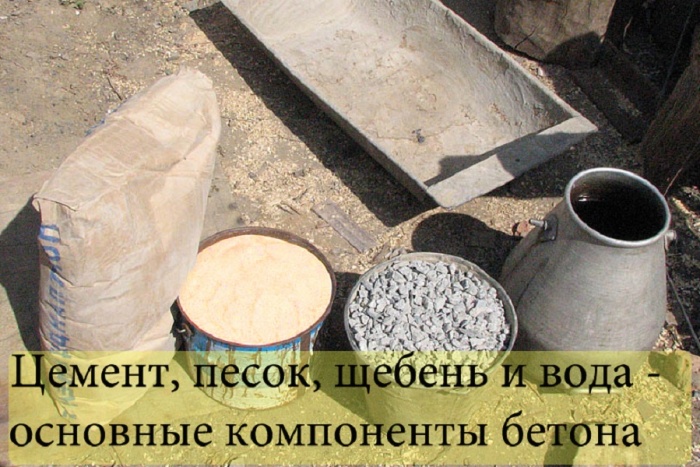
Increased soil moisture forces an increase in the proportion of cement. Information from reference books and manufacturers' recommendations will help you calculate the required proportion. The quality of concrete mortar is also influenced by fractions related materials(crushed stone, sand or gravel). Cement that is not sold in a timely manner loses strength, as a result, the M500 grade gradually corresponds to the indicators characteristic of the M400 grade, and then is converted into the M300 grade. Therefore, the concrete for a strip foundation must be “fresh”.
When calculating the need for components for pouring a strip foundation, one feature should be taken into account: often the cost of the material is indicated for 1 ton, and a private developer requires a volume of cubic meters. And here we must remember the regularity: material with fine fraction in 1 m3 there is more mass than larger fractions.
Common grades of cement may have the following proportions:

Attention! Quality solution it turns out when the grade of Portland cement is twice as high as the grade of concrete for the strip foundation. That is, when forming a supporting structure in private construction, durable concrete grade M200 is sufficient; cement grade M400 is used for it.
More durable grades of concrete, starting from M300, require smaller ratios, so the proportion to the cement grade can be reduced to 1.5. For concrete grade M400, cement grade M600 will be sufficient.
The grade of concrete for the foundation is determined taking into account the planned load, implement right choice Manufacturers' recommendations will help:
Comment! The shrinkage coefficient increases the quality of concrete: the lower the indicator, the higher the strength. The required parameters are achieved by introducing special additives.
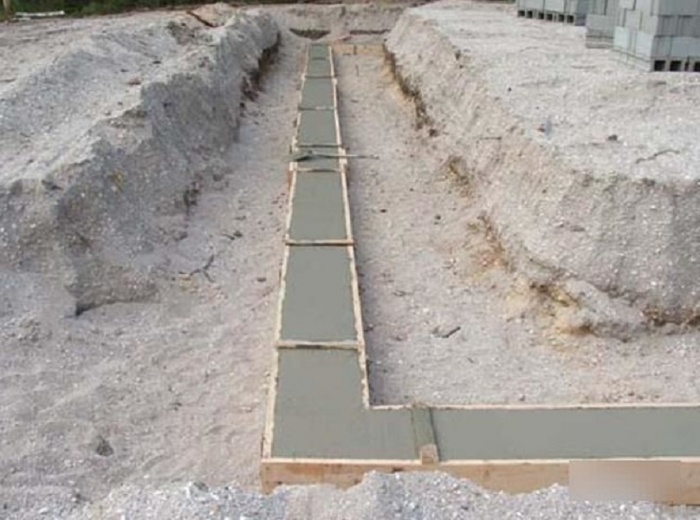
Concrete for the foundation plays a key role in the formation of a durable structure. M200 grade material will help achieve the goal, but there are a number of nuances that should be taken into account during private construction:
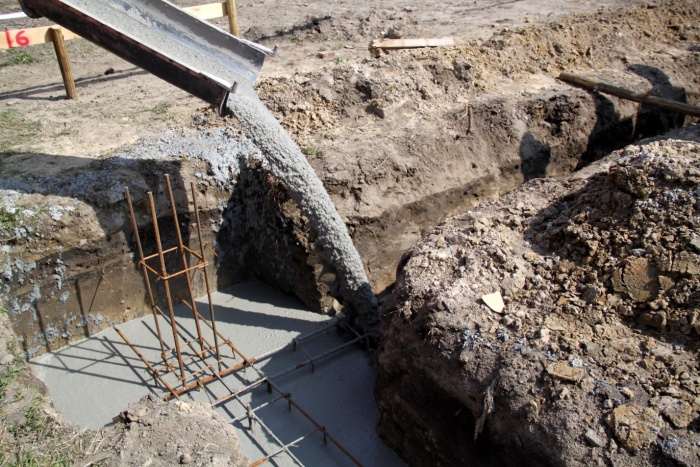
Private construction requires a balanced approach at every stage. An informed choice of concrete grade will help create a reliable strip foundation that will preserve the integrity of the entire structure for a long time.
IN modern world There are a number of brands of concrete and they are designed for a variety of needs. The price of concrete depends on its composition and the number of cubes. To select a brand of concrete, you can contact specialized companies, their experts will advise you on any issue related to concrete or mortar.

Before starting construction, you need to find out which brand of concrete is right for you. This question arises when you do not have one, which always indicates the brand of concrete and other parameters. To be honest, there isn't that much choice.
To choose a brand of concrete, you need to find out what the weight of your structure will be, you need to calculate all operational loads and also take into account the fact that the internal and external finishing structure also increases weight. You also need to pay attention to the fact that you may need to make holes in the foundation during installation or when decorating. This leads to a decrease in the strength of the foundation. 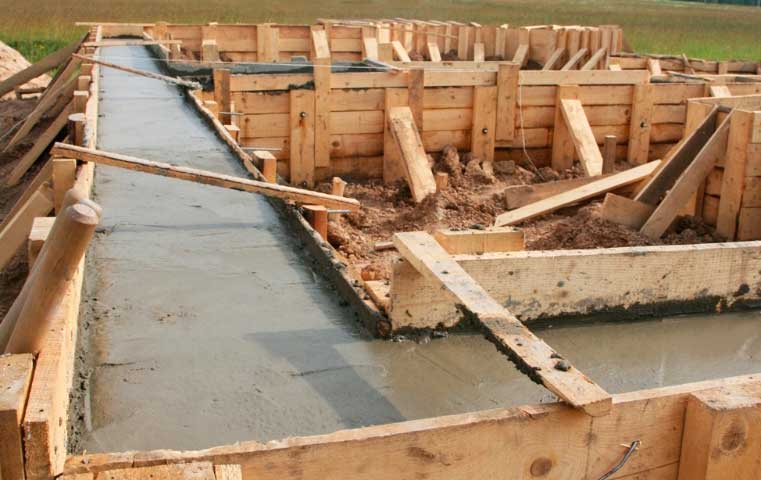

If the structure is erected on rock or sandy soil, it is best to use M250 concrete.
High grade concrete M350 is used for areas where groundwater does not lie deep, it is also suitable for construction.
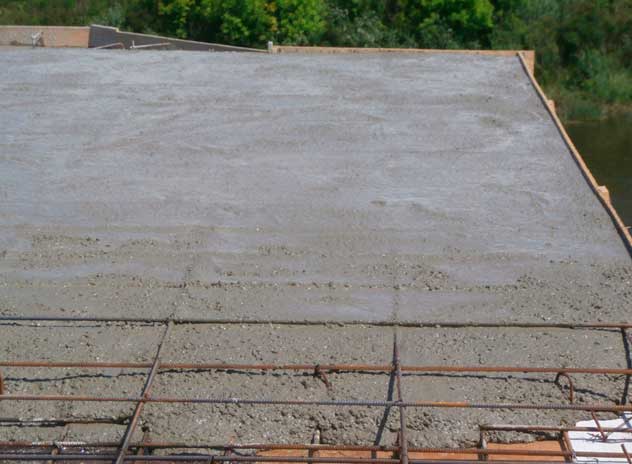 Previously, the foundation was made of reinforced concrete slabs. IN modern construction They use a monolithic foundation, which is cast from concrete. In addition to the classic monolithic foundation, it is also possible to cast bored piles and.
Previously, the foundation was made of reinforced concrete slabs. IN modern construction They use a monolithic foundation, which is cast from concrete. In addition to the classic monolithic foundation, it is also possible to cast bored piles and.
Therefore, people are puzzled by the choice of concrete for the foundation. The grade of concrete is one of the main issues for performing certain tasks.
From type monolithic design and the conditions of use depend on the choice of concrete grade.
Before choosing concrete for the foundation, you need to familiarize yourself with some criteria:
Of course, load is the main parameter when choosing a concrete grade.
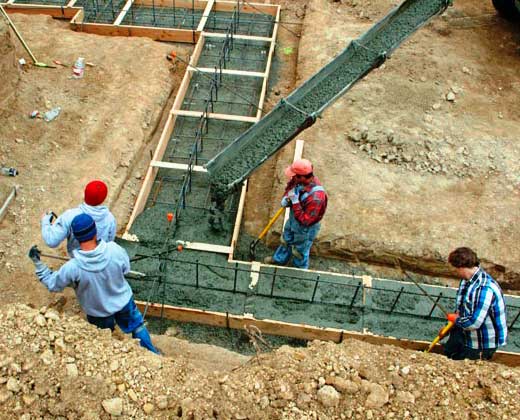 When choosing a concrete grade, it is necessary to take into account the characteristics of the soil. Concrete M200 and M250 are suitable for rocky and sandy soils. For clay soils, higher grades of concrete are used, since when the soil freezes, it increases in volume, so the foundation deforms unevenly.
When choosing a concrete grade, it is necessary to take into account the characteristics of the soil. Concrete M200 and M250 are suitable for rocky and sandy soils. For clay soils, higher grades of concrete are used, since when the soil freezes, it increases in volume, so the foundation deforms unevenly.
To prevent this from happening, it is necessary to bury it to a depth below the freezing depth of the soil or use high-grade concrete.
Before choosing a brand of concrete for the foundation, you must not forget about the basement. If you are making a house with basement, then you will need to do good waterproofing, while for the foundation it is not necessary to use an expensive brand of concrete. Or, to avoid incidents, take a more expensive brand of concrete with a high moisture resistance. 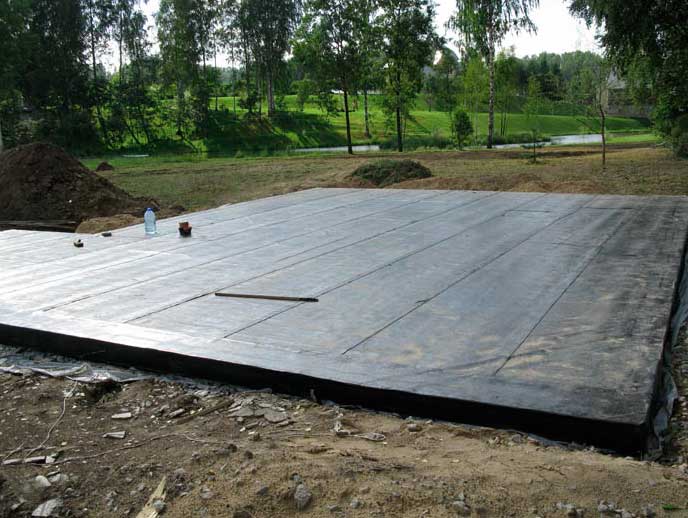
To select concrete for the foundation, it is necessary to take into account its weight. To determine the weight of concrete, you need to know what aggregate the manufacturer uses.
Concrete cube weight:
The weight of concrete must also be taken into account when choosing it; the load on the soil and the effect on soil swelling depend on this.
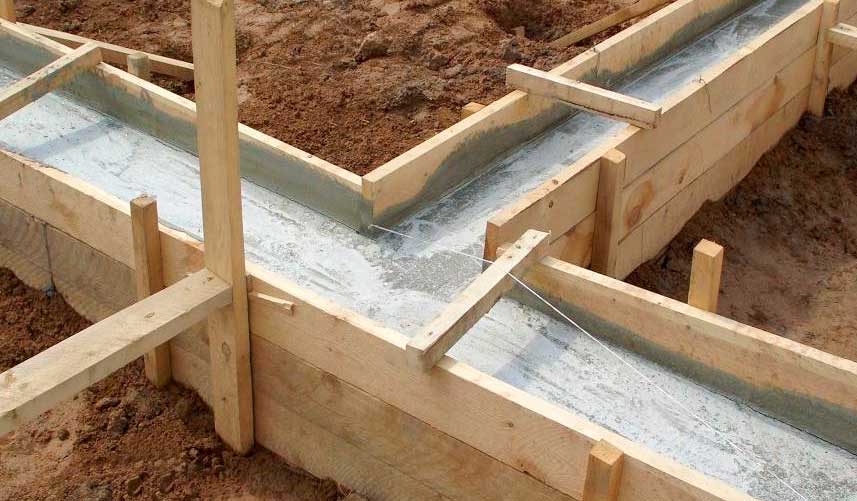 The brand of concrete affects its consumption; it is also necessary to take into account the laying conditions. The heat treatment of some brands affects their consumption. Concrete consumption is indicated in technical documents and its quantity is 1m3. To calculate the required amount of concrete, you need to multiply 1 m3 by the height of the foundation being poured.
The brand of concrete affects its consumption; it is also necessary to take into account the laying conditions. The heat treatment of some brands affects their consumption. Concrete consumption is indicated in technical documents and its quantity is 1m3. To calculate the required amount of concrete, you need to multiply 1 m3 by the height of the foundation being poured.
The brand of concrete that suits you must meet the necessary parameters. The quality of the foundation depends on this.
 If you decide to build in winter, you will face some difficulties. Water freezes in the cold and concrete does not gain strength. To use concrete in winter, winter additives are used that prevent water from freezing and the concrete has time to gain strength.
If you decide to build in winter, you will face some difficulties. Water freezes in the cold and concrete does not gain strength. To use concrete in winter, winter additives are used that prevent water from freezing and the concrete has time to gain strength.
Used as additives calcium chloride, soda ash, sodium chloride, ammonium hydroxide, ammonium nitrate, sodium nitrate and others.
In industry there are additives up to -35 degrees below zero.
When mixing a mixture using antifreeze additives, it is necessary to strictly follow the technology and observe safety precautions.
Regardless of which building is planned to be built (skyscraper made of glass and metal, dacha, cottage, fence, garage), its basis will be the foundation. The responsibility that falls on construction specialists in the process of producing the foundation is quite high. When calculating and choosing a concrete grade for the foundation of a house or other building, one should take into account a large number of parameters on which the durability, stability, and safety of the structure being built depend.
One of the components of the foundation is concrete. The result of all work on the construction of the facility will depend on how correctly the solution is selected and ultimately used.
Return to contents
To decide what brand of concrete you will need for the foundation, you need to take into account several parameters, including:
The expected load is the most important indicator when choosing.
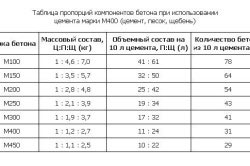
When calculating the load, it is clear that a structure made of reinforced concrete will be much larger in weight compared, for example, with a prefabricated panel building. This may lead to the fact that in the first case it is necessary to take a mixture of concrete with increased strength and viscosity characteristics. For buildings that have a lot of weight, we can recommend a brand from M350 and above. Grade up to M350 should be used for light buildings.
The next parameter is soil properties. Soil characteristics significantly influence. Resistance to possible deformations (which may be caused by displacement, for example, sandy, loamy or other similar types soil) can be achieved by selecting a special one for the foundation. If the soil is sandstone or rocky, grade M200 or M250 may be sufficient. If there are clay deposits in the area, then M350 may be a more suitable brand.
One of the problems with clay is heaving. If the foundation is built shallow, during the process of freezing in winter period over time, an uneven rise of the soil will be observed, which depends on the speed and degree of saturation with water.
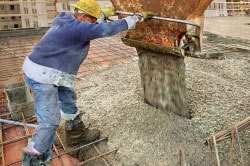
Before you start building a house, you need to choose the type of foundation and determine what concrete will be needed to pour it.
There is 1 piece of advice on this matter. In such cases, you will need not only to choose the right brand of concrete, but also to dig much deeper than the frost line in order to avoid possible problems further.
The next parameter is groundwater. The proximity of groundwater will influence the search for it. Water impermeability is a criterion that should be taken into account primarily when groundwater is close to each other.
Please note that you will definitely need to keep in mind the seasonal changes in the existing area. They can lead not only to rising waters, but also to their emergence to the surface. This may entail negative impacts on the foundation.
Return to contents
In order for the structure to maintain its integrity in the event of possible danger associated with groundwater, the following recommendations should be followed:
Return to contents
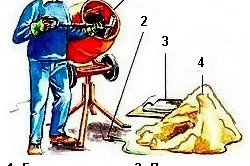
Cement. When determining what composition and grade of concrete is needed for the selected type of foundation, you should know that there is a fairly large number of varieties of cement, including: without additives and with additives, Portland cement, normalized, quick-hardening, waterproof, plasticized, frost-resistant, resistant to aggressive environments and etc.
For the foundation, the M300 brand is most suitable, but builders recognized the M500 brand as optimal.
Fittings. Speaking about which reinforcement is most suitable for the foundation, it is worth knowing that experts advise choosing a cage structure with perpendicularly connected rods. Reinforcement bars for foundations are distinguished by a corrugated surface, which gives the concrete the opportunity to completely envelop the element that is embedded in the foundation.
It is important to note that the reinforcement must be completely included in the thickness of the base, without reaching the bottom.
Solution. When choosing a brand of mortar for foundations, you need to know that, in addition to cement, clay and lime can be added to the mortar, and therefore the choice expands. Mortars can be cement with different ratios of incoming components, cement-lime, cement-clay, which are used for foundations on dry soil. If the soil moisture increases, you will need to increase the amount of cement included in the composition.
Return to contents
The grade of cement for a strip-type foundation for manual laying can be as follows:
The foundation is the basis of any building, regardless of its size and purpose. The foundation bears the load from all structures located above. The reliability of the foundation depends on many factors, the main one of which is the strength of the foundation concrete. Except physical characteristics(width and depth), the grade of concrete for the foundation of a private house must correspond to the loads. In this article we will tell you how to correctly determine the grade of concrete for a foundation, what types of foundations exist, and what grades of concrete are used for constructing certain types of foundations.
Distinguish the following types foundations;
Especially often used in private construction. Suitable for heavy houses made of concrete and brick. It is a reinforced concrete strip of calculated width and depth, arranged under load-bearing walls buildings, usually with basements.
The depth of the strip foundation exceeds the depth of soil freezing. Shallow strip foundations are sometimes installed under light (usually wooden) houses.
Pillar supports at the corners of the building and at the intersections of walls.
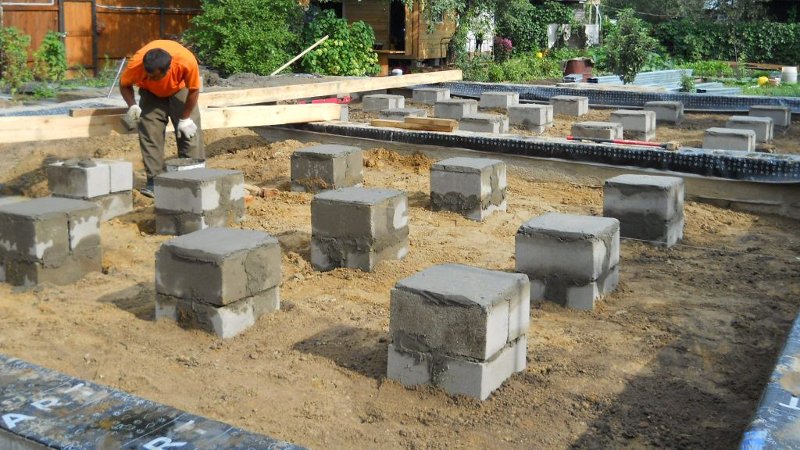
Built on stable soils for lightweight buildings. The lintels between the pillars can be brick, concrete, or rubble. Basements are not expected with this type of foundation. This type of foundation is cheaper than a strip foundation, but has limitations in use.
Used on highly compressible soils for light (wooden) structures.
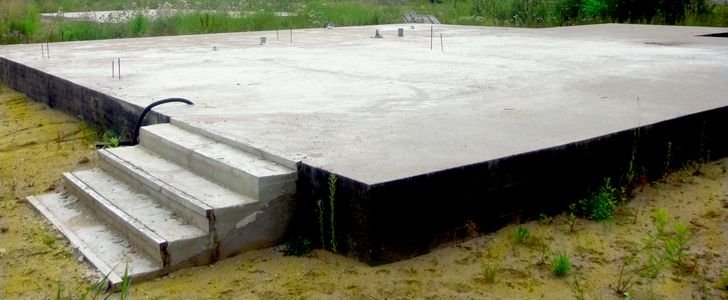
In case of soil movement monolithic slab prevents the structure from collapsing. Construction is done without the use of equipment, and planning possibilities are unlimited. The disadvantage is the impossibility of constructing a basement and the high cost.
It is installed on weak moving soils for structures with high loads. The piles are predominantly reinforced concrete with a load-bearing load of 2 - 5 tons per unit.
The head parts of the piles are connected to form a support. Convenient in dense urban areas. Reliable and durable, does not depend on groundwater levels. The method is expensive and is not used in private construction.
Member of the group monolithic foundations. The base of such a foundation is the floor of the house.
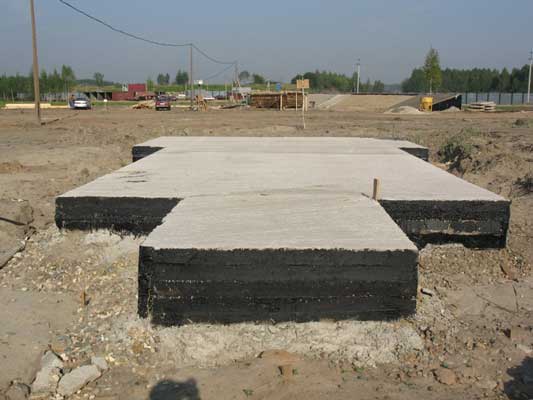
The foundation is expensive, it is arranged only for small houses. The characteristics correspond to a monolithic foundation.
Such a foundation protects the building from ground deformations.
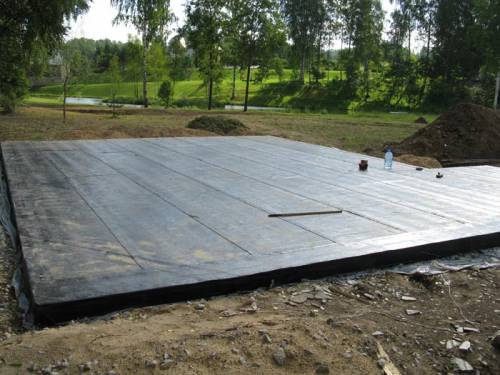
It is installed on waterlogged, weak-bearing and bulk soils.
Included in the group of pile foundations - the pile in this case is a pipe with a blade.
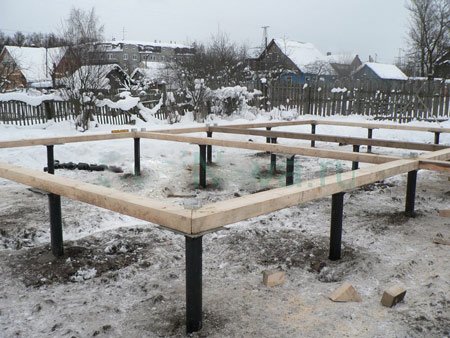
It is used on flooded construction sites, on heaving soils, unstable soils with complex terrain.
The type of foundation chosen depends on the characteristics of the building under construction and the conditions of the construction site. The foundation is selected according to:
The criteria by which the type of foundation is determined are set out above. If exists finished project object, then it indicates the selected type, its characteristics and the grade of concrete for the construction of the foundation. Each type of building and structure under construction corresponds to the grade of concrete that is used in the construction of the foundation.
M100 is used for footings in preparatory stages construction. A foundation made of this grade of concrete can be built for wooden houses, garages, fences, farm buildings.
M150 is used for preparatory work, for pouring shallow foundations of strip type, small one-story houses, houses made of aerated concrete, foam concrete and cinder block. Can be used for foundations for garages and agricultural buildings.
· M200 is used in the construction of private houses up to two floors with light floors. Concrete of this grade is classified as structural and is used for the production of reinforced concrete products.
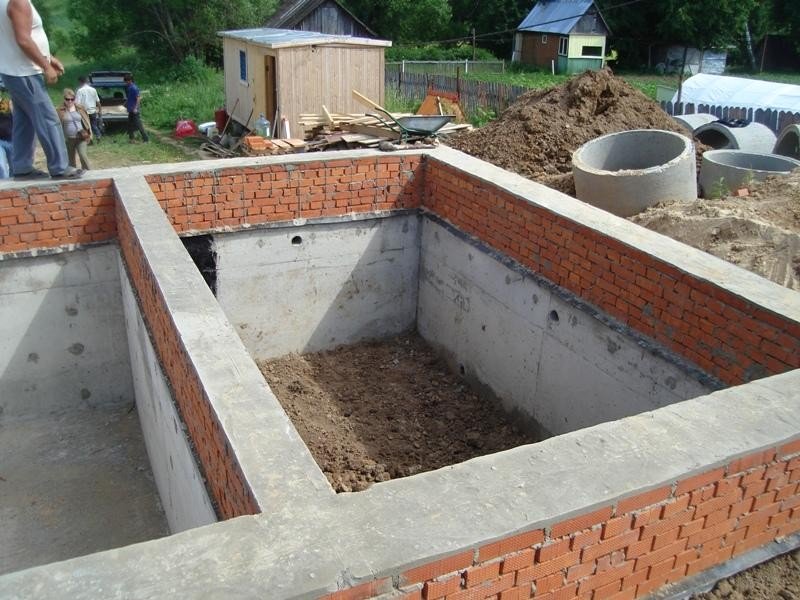
M250 and M300 are used for the construction of large foundations individual houses. Concrete M300 is suitable for monolithic floors.
· M400 is used for the construction of foundations for multi-story construction and floors.
Some of the most important characteristics influencing the choice of concrete for the foundation.
A characteristic that reflects the ability of concrete to withstand compressive loads. M (concrete grade) is the average value of the maximum pressure per 1 sq. cm that a concrete sample can withstand 28 days after mixing. B (concrete class) - more modern version strength characteristics taking into account a variation of 13%. The higher the M and B values, the stronger the concrete.

It is impossible to check what brand of concrete it is. With a special device Using a sclerometer, you can determine the quality of the mixture directly when pouring concrete into the formwork, but this requires specialists.
Characteristics of the flowability or workability of concrete. Index P from 1 to 5 determines the ability of the solution cone to settle by a certain amount. The higher the mobility of concrete, the more liquid concrete used for filling. In the foundations under individual houses Concrete with mobility P-2 or P-3 is used. For ease of installation, do not add to the mixer more water- this inevitably reduces the strength of concrete and can be dangerous for the foundation of the house.
The index (W) is indicated by numbers from 2 to 20 and is called the water resistance coefficient. The water resistance of the prepared concrete can be increased by using special hydrophobic additives in the production of concrete mixture for the foundation.
It is designated by the index F and has values of 25 – 1000. Characterizes the ability of water-saturated concrete to withstand “freeze-thaw” cycles while maintaining strength characteristics. Coefficients F100 – F200 are typical for individual construction. The value depends on the construction conditions (climate, humidity, type of soil), as well as the quality of the foundation waterproofing work.
Concrete contains four components: cement, crushed stone, sand, and water. The main thing is that the concrete must exactly match its brand in terms of strength. Briefly, the requirements for each material:
Active component of concrete. For foundation concrete, cement M400 or M500 is used (not to be confused with the brand of concrete!).

The selected cement must have a minimum shelf life (after a month of storage at a temperature of 20 o C indoors, M400 cement loses its properties by a quarter, and by half when stored outdoors).
A filler that provides strength to concrete. For a reinforced structure, which is the foundation, according to the standards, a crushed stone fraction of up to 40 mm is required. To choose the desired faction, you need to take into account the minimum distance between the reinforcing bars. The selected crushed stone of the maximum fraction should not exceed this distance by more than ¾.
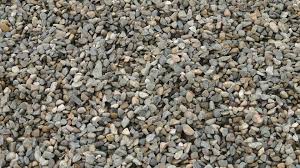
It is preferable to use granite crushed stone or crushed gravel 5 - 20 mm for pouring the reinforcement frame and 20 - 40 mm for pouring on the ground. Crushed limestone can only be used to prepare concrete for foundations on dry soils.
Will do quarry sand- it must be washed and sifted with a minimum amount of clay impurities.
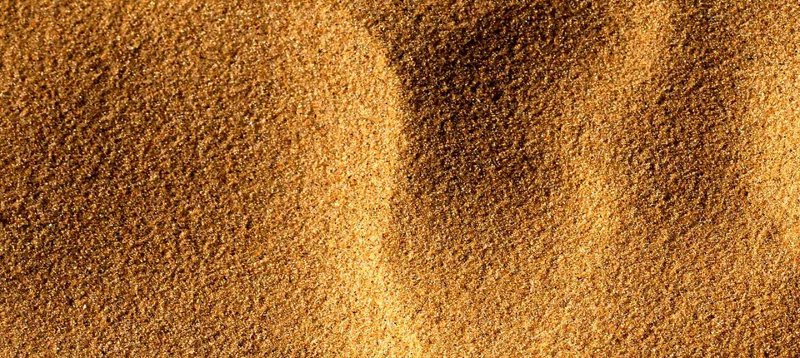
River sand is finer and usually contains a lot of clay, which is undesirable for concrete production. If there is no choice, then the river sand should be thoroughly sifted and washed.
Pure water without biological inclusions, petroleum products, oils. Tap water is usually used.
The ratios of components of concrete mixtures of various brands are shown in the table:
You can watch the video for making concrete at home.
The choice of concrete grade is dictated performance characteristics And economic feasibility. A strong foundation, if it is not necessary, will lead to unjustified construction costs, so it is important to correctly determine what grade of concrete is needed. As a rule, private housing projects in Russia offer strip foundations (more than 70% of the total are being built). To determine the grade of concrete for a strip foundation, you need to take into account everything that affects the foundation.

To determine the grade of concrete for building a foundation, you need to use the recommendations outlined, then take into account additional construction conditions and, depending on them, make a final decision on the grade of concrete.
What kind of concrete is needed for the foundation of a house? updated: November 25, 2016 by: Artyom
Poured foundations made of pure cement mortar filled with medium or fine crushed stone (gravel) and iron reinforcement are often used in construction. The quality and durability of objects constructed in this way is directly affected by the chosen concrete grade for foundation.
The main characteristic of concrete is its strength. No less important are the parameters of frost resistance and water permeability. All this is achieved by using a certain ratio of components during preparation. concrete composition(cement, crushed stone, lime, plasticizers and other chemical additives).
To solve, what kind of concrete is needed for the foundation In a particular case, a number of factors must be taken into account.
The most important of them:
Second– soil characteristics.
Third– climatic and operating conditions.
Fourth– the type of foundation itself (strip, pile).
Let's consider each of the above factors on which the used grade of concrete for pouring the foundation.
1. Load on the base is a key criterion for strength concrete base.
M100, M150 - used for compact agricultural buildings, light garages, wooden and foam concrete one-story houses, fences.
M200 - the most common in single-story and two-story building brand of concrete. Suitable for small buildings with light floors.
M250, M300 – reliable and durable concrete, withstanding loads from large private houses, up to 5-story cottages.
M350, M400, M500 – used for the installation of multi-storey buildings high-rise buildings(up to 20 or more floors).
Installation of a monolithic concrete base is one of the most expensive activities. It is very important to correctly calculate the required grade of concrete for the foundation; the final cost of the structure depends on this. High quality concrete mixtures, as a rule, are used only if there are supporting calculations and justification for the need for their use. In most cases, the material M200-M250 is used.
2. Soil characteristics also influence whether what concrete to use for the foundation.
Rocky and sandy soils make it possible to use concrete grade M150-M200 in the construction of one- and two-story buildings. Another thing is clay and loam.
Professional builders know that main problem clayey soils is their increase in volume due to freezing. To prevent possible deformation and destruction of the monolith, the base is buried below the freezing level. However, in this case it will not be possible to completely eliminate soil heaving in the cold, so the foundation should be filled with stronger grades of concrete (from M250 and above).
3. Very important properties concrete are its water permeability and frost resistance.
By water permeability the material is divided into the following grades: W2, W4, W6, W8. An increase in indices after the designation “W” characterizes a decrease in ability building material allow liquid to pass under the influence of capillary forces or hydrostatic pressure. W8 concrete allows water to pass through very poorly.
The degree of water permeability of a concrete base depends not only on the ratio of the components included in the mixture, but also on what type of concrete was used brand of cement for foundation. The water permeability of concrete can be reduced using hydrophobic and pozzolanic Portland cement.
If the foundation is laid in the ground with high humidity, or high level groundwater, it is more advisable to use concrete of higher grades (W6, W8) with a minimum degree of water permeability.
Classification of concrete by frost resistance characterizes the ability of the hardened construction mixture withstand alternate repeated thawing and freezing in a saturated state. In harsh winter conditions, especially when building on permafrost, this indicator is extremely important.
The following grades of concrete are distinguished according to the degree of frost resistance: F35, F50, F75, F100, F150, F200. As the grade increases, the number of freeze-thaw cycles that concrete can withstand increases (according to numerical indicators).
It is also important to take into account humidity conditions and groundwater levels. If the foundation is protected from precipitation and groundwater, concrete grade F75 is sufficient. In more extreme conditions use F100 and higher.
4. Main types of fillers concrete foundations– strip and pile.
The general principle is this: low grades of concrete are used for strip foundations, and higher grades for pile foundations. The use of piles as supports is justified in the construction of high-rise buildings and on marshy soils, where pile foundation is the only option for private houses.
Foundations with shallow and medium depths (having a bearing capacity of up to 135 kgf/cm²) are made from concrete grades M100, M150. Best brand concrete for foundation pile type, used at high groundwater, this is M350 and higher (preferably on granite aggregate). In other cases the best option are brands M200, M250. This type of base has bearing capacity up to 262 kgf/cm².
Ready-mixed concrete of the appropriate grade acquires all of the above characteristics only if it is maintained the right technology its hardening (gradually). The most intensive setting occurs in 1 week, complete hardening occurs 28 days after pouring. In this case, drying conditions must be favorable.